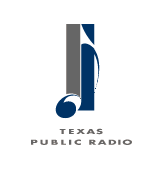Texas Public Radio
Texas Public Radio, or TPR is the on-air name for a group of public radio stations serving south central Texas - including San Antonio and the Texas Hill Country - and the Big Country region of West Central Texas. All are affiliated with National Public Radio.
 | |
| Broadcast area | San Antonio, the Texas Hill Country, and Snyder, Texas |
|---|---|
| Branding | Texas Public Radio |
| Slogan | Hear Yourself Think |
| Programming | |
| Format | KSTX, KTPR, KTPD, KCTI and KVHL: News/talk KPAC: Classical music KTXI: News/talk/classical music |
| Affiliations | National Public Radio |
| Ownership | |
| Owner | Texas Public Radio |
| History | |
| Call sign meaning | KSTX: San Antonio, TeXas KPAC: Public ACcess KTXI: TeXas Ingram KTPR: Texas Public Radio KCTI: Cradle Texas Independence |
| Technical information | |
| Facility ID | KSTX: 65334 KPAC: 65335 KTXI: 77699 KCTI: 24651 |
| Class | KSTX: C1 KPAC: C1 KTXI: C2 KCTI: C |
| ERP | KSTX: 72,000 watts KPAC: 69,000 watts KTXI: 50,000 watts KTPR: 19,000 KVHL: 1,500 watts |
| HAAT | KSTX: 240 meters KPAC: 240 meters KTXI: 138 meters KTPR: 139 meters |
| Links | |
| Webcast | Listen Live PLS |
| Website | www.tpr.org |
The group consists of six stations on the lower end of the FM dial: all-news station KSTX (89.1 MHz, San Antonio), all-classical music KPAC (88.3 MHz, San Antonio), news/classical KTXI (90.1 MHz, Ingram; serving the Hill Country), all-news KTPR (89.9 MHz, Snyder; serving the Big Country), all-news KVHL (91.7 MHz, Llano; serving the Highland Lakes), all-news KTPD (89.3 MHz, Del Rio); and one AM station, all-news KCTI (1450 AM, Gonzales; serving the I-10 corridor).
History
KPAC, the oldest station in the group, signed on for the first time on November 7, 1982 as a 24-hour classical music station. It was owned by the Classical Broadcasting Society of San Antonio.

As San Antonio's growth exploded during the 1980s, many of the city's new residents wanted more choices in NPR programming. A group called San Antonio Community Radio had won a construction permit for the second public radio frequency in San Antonio in 1981, but hadn't been able to get on the air. To solve this problem, the Classical Broadcasting Society and San Antonio Community Radio merged in the summer of 1988 to form Texas Public Radio. The new group was able to sign on KSTX for the first time on October 31, 1988 bringing a full-time NPR station to San Antonio. Before 1988, San Antonio was the largest city in Texas, as well as one of the largest in the nation, without a clear signal from an NPR station.
However, several portions of the Hill Country were still without a clear NPR signal. To fill in this gap, KTXI was brought online on October 7, 1998, airing a mix of NPR news and classical music. Its signal covers Fredericksburg, Kerrville and other portions of the central Hill Country.
KTPR was launched on December 3, 2012 to serve the Big Country region, and in October 2013, KVHL began broadcasting to the Highland Lakes area of Texas. KTPD began broadcasting to Del Rio on May 5, 2016, and TPR began broadcasting its programming on KCTI 1450 AM in Gonzales on January 2, 2017.
Local programs
Locally produced programs include Texas Matters, The Source, Fronteras, HearSA, and a popular music program, World Music with Deirdre Saravia.
The KPAC Blog features classical music news and analysis.
The Cinema Tuesdays series is a summertime weekly film event featuring a carefully selected film each week. TPR's Nathan Cone curates the series. Silver Solutions is an annual Resource Fair for seniors and their families. Sponsors and vendors are available to provide information on life enrichment, care-giving, community support services, living options, health care options, cognitive matters, planning ahead, and mobility, among others.
Views & Brews is a TPR-hosted event that discusses topics relevant to TPR listeners. Past Views & Brews topics included Microbreweries, Urban Homesteading, Placemaking, Cycling, among others.
Think Science is a quarterly TPR-hosted panel discussion event that focuses on developments across a wide variety of scientific fields.
References
External links
- KSTX in the FCC's FM station database
- KSTX on Radio-Locator
- KSTX in Nielsen Audio's FM station database
- KPAC in the FCC's FM station database
- KPAC on Radio-Locator
- KPAC in Nielsen Audio's FM station database
- KTXI in the FCC's FM station database
- KTXI on Radio-Locator
- KTXI in Nielsen Audio's FM station database
- KTPR in the FCC's FM station database
- KTPR on Radio-Locator
- KTPR in Nielsen Audio's FM station database
- KVHL in the FCC's FM station database
- KVHL on Radio-Locator
- KVHL in Nielsen Audio's FM station database